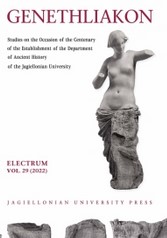Magnetic Prospection in the Eastern Lower City of Artashat-Artaxata in the Ararat Plain of Armenia
Magnetic Prospection in the Eastern Lower City of Artashat-Artaxata in the Ararat Plain of Armenia
Author(s): Achim Lichtenberger, Cornelius Meyer, Torben Schreiber, Mkrtich H. ZardaryanSubject(s): Archaeology, Cultural history, Ancient World
Published by: Wydawnictwo Uniwersytetu Jagiellońskiego
Keywords: Artaxata; Ancient Armenia; archeology of Armenia;
Summary/Abstract: In March of 2021, the Berlin-based company cmp continued geophysical prospection works at the ancient city of Artashat-Artaxata (Ararat Province, Armenia). The city was founded by Artashes-Artaxias I in the early 2nd century BC and served as his capital. First magnetic measurements were conducted by the Eastern Atlas company in September 2018. In 2021, during the 5-day survey a total surface of approximately 19.5 ha was investigated by use of the LEA MAX magnetic gradiometer array. This system was configured with seven fluxgate gradiometer probes, similar to the system used in the first survey of 2018. The investigated areas of the Eastern Lower City of Artaxata, located to the south of the investigated field of 2018, had good surface conditions with a moderate amount of sources causing disturbance. However, the general level of the magnetic gradient values measured was significantly lower compared to the 2018 data. Despite the lower magnetic field intensity, a continuation of linear structures towards the south was observed. These lines, most likely reflecting streets and pathways, criss-cross the central part of the Eastern Lower City in a NW–SE and NE–SW direction and exhibit partly positive, partly negative magnetic anomalies. Attached to them, some isolated spots with building remains were identified. The negative linear anomalies point to remains of limestone foundations, as detected in the northern part of the Lower City. The low magnetic intensity and fragmentation of the observed structures are most likely due to severe destruction of the ancient layers by 20th-century earthworks for agricultural purposes. Moreover, the southern part of the surveyed area was affected by major changes caused by modern quarries at Hills XI and XII. In general, the results of the two magnetic prospection campaigns greatly aid our understanding of the archaeological situation in the area of the Eastern Lower City of Artaxata, justifying further investigations that will surely contribute to greater contextualization of the identified archaeological structures. The full data sets are also published in open access on Zenodo.
Journal: Electrum. Studia z historii starożytnej
- Issue Year: 2022
- Issue No: 29
- Page Range: 109-125
- Page Count: 17
- Language: English

